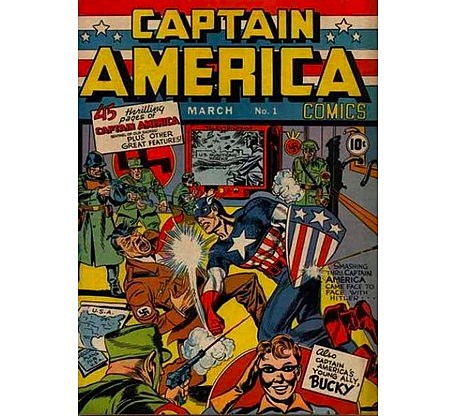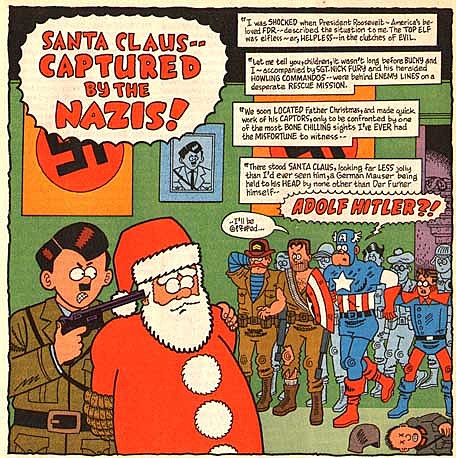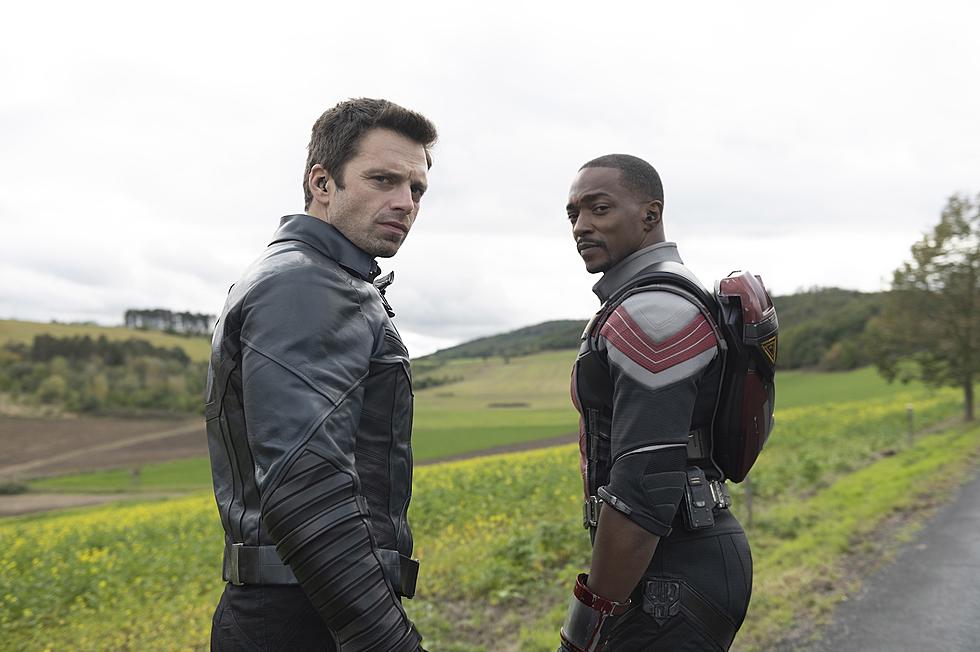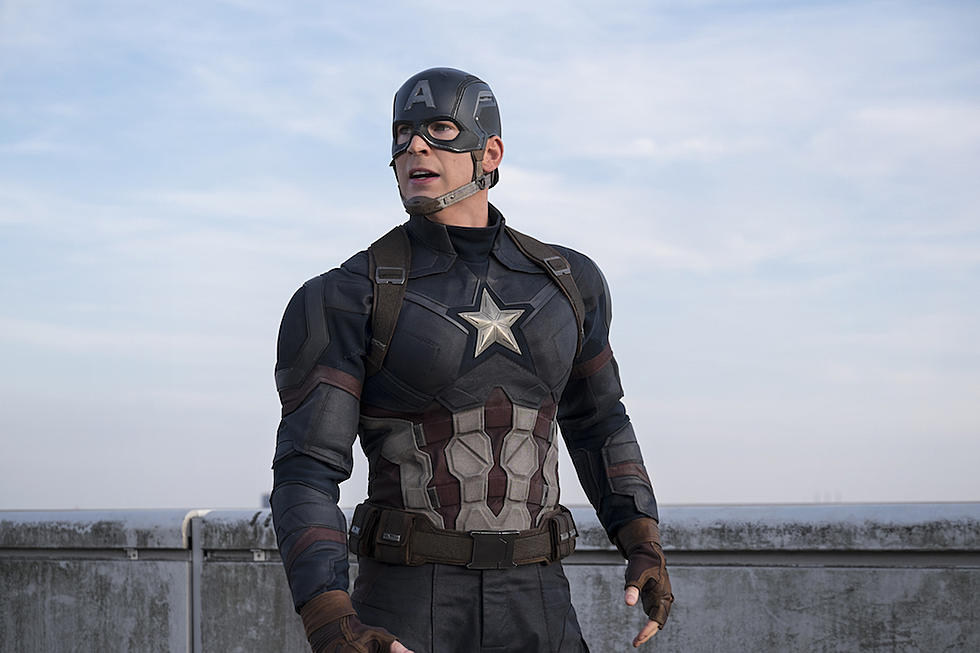
Inglourious Basterd: The History of Hitler in Comics
 Quentin Tarantino's "Inglourious Basterds" hits theaters this Friday and there's already a short comic preview of the film available. Tarantino's an admitted comics fan, often slipping both subtle and not so subtle references to classic comics characters into his work.
Quentin Tarantino's "Inglourious Basterds" hits theaters this Friday and there's already a short comic preview of the film available. Tarantino's an admitted comics fan, often slipping both subtle and not so subtle references to classic comics characters into his work.
In his latest film he's including a figure who has appeared in the pages of comics steadily for decades now: Adolf Hitler. The rise of comics as popular reading in the U.S. coincided with the beginning of the Second World War and the regime of one of the most terrible human beings the world's ever witnessed. Even while he was still alive, Hitler's appearances in comics books were usually done in a light-hearted manner. But in the appearances that followed long after his death and the end of the war Hitler, the comic book character, became something unreal. Sometimes a fearsome 20th century boogey-man, sometimes a punchline, sometimes both. Here's a sampling of but a few of those appearances, as there's far too many to present them all:
[Read the full list after the jump...]1. WWII COMICS COVERS
Even before the United States of America officially entered the war in December 1941, its costumed heroes were taking on Hitler. March 1941's Captain America #1, by Joe Simon and Jack Kirby, used this now famous image of Cap landing a heavy right hook into Hitler's face for its cover.

Over the course of the World War II, comics publishers were eager to show their support of the war effort right on the front of their books, and Hitler, along with other Axis Power leaders, was an obvious target. Superman and Batman soon followed Captain America's example:

There's a good run down of cover images collected here. Honestly, this one's probably my favorite:

(Interesting historical note - that's the same expression Hitler used on British Prime Minister Neville Chamberlain at the 1938 Munich Conference. After five hours, an exasperated Chamberlain threw up his arms and exclaimed "Fine, take the Sudetenland!")
These images all left a lasting mark on more than just comics culture, particularly "Captain America" #1. There's an important scene in Michael Chabon's Pulitzer-prize winning "The Amazing Adventures of Kavalier & Clay" in which the novel's protagonists decide to have the first cover of their own Golden Age hero, The Escapist, giving Hitler a solid punch to the jaw. Mike Mignola and Dave Stewart later recreated that cover for Dark Horse. And the recently released issue #2 of "Captain America Reborn" shows Cap with Hitler in a choke hold.
2. The Fantastic Four Vs. Hitler(?)
"Fantastic Four" #21, by Stan Lee and Jack Kirby, was published in 1962 and introduced a new antagonist for the team: The Hate-Monger.

Employing a weapon called the "H-Ray", the Hatemonger was able to cause the group to fight against one another until, with the help of Nick Fury, they were able to overcome the ray's effects. And when the H-Ray accidentally struck some of his own soldiers, the Hate-Monger ended up shot to death by his own men. Reed Richards then removed the hood from the Hate-Monger's body to reveal.

Yup. It was Hitler all along.
In real life, the circumstances surrounding Hitler's death were something of a mystery. Because his body was cremated following his suicide and the only source of autopsy information was the Soviet government, some people chose not to believe the official view. Conspiracy theories of his escape arose. For some, Hitler had been like a kind of movie monster, and unless they saw the body they couldn't be convinced something responsible for so much suffering and destruction could be killed so easily.
This being a comic book, it turned out the Fantastic Four had killed a clone. Hitler, as far as the Marvel Universe was concerned, was just as dead as he was in reality.
But on a later occasion when the Fantastic Four encountered Hitler, circumstances were different.

This time, in a story by John Byrne and Al Gordon, the group found themselves somehow transported back in time prior to World War II, once again with Nick Fury along for the ride. Fury quickly decided how he wanted to spend his trip to the past.

The rest, however, worried about the effect killing Hitler would have on history. And in the end, when they've all got another Hitler corpse on their hands, it turns out not to be a clone this time. No, instead it was all a dream. Not theirs, but an imagined past created by a powerful mutant.
3. "Marvel Age" #109
"Marvel Age," a magazine with articles, interviews, and artwork published by Marvel for Marvel fans, included a short comic in issue #109. A special for the holiday 1992 issue, the comic had Captain America telling a story of his past Christmas-related adventures to a group of orphans visiting Avengers' Mansion. Here's the highlight:

Your eyes do not deceive you. That is indeed Adolf Hitler holding a gun to Santa Claus' head. With Hitler existing in comics as a personification of absolute evil, it's not surprising Marvel had him attempt to destroy the one person children see as a being of absolute good: Santa himself. It was only a matter of time until that story was told. And by "it was only a matter of time", I of course mean that it had already happened in a Superman story fifty years earlier during World War II.

The Marvel Age comic is notable for one other thing, though. Its surprising level of self-awareness:

4. "Savage Dragon/Hellboy" #34 and 35
These two issues of Savage Dragon, printed in late 1996, were a crossover event that saw not one, but two battles with Hitler. The first came in the prologue of the first issue, which told the events of a 1952 fight in Romania between Hellboy and a mechanical battle-armored Adolf Hitler.

Hellboy walked away victorious, leaving Hitler presumably dead in a fiery explosion. Unfortunately, his brain survived the blast and was preserved. In the body of a gorilla. Because that is clearly what you do if you have Hitler's brain in a jar.

Much like the Hate-Monger, Brainiape-Hitler possessed the ability to cause his enemies to fight against one another, which he makes Savage Dragon and Hellboy do until they're able to shake it off and finish him off for good, this time.
5. I Killed Adolf Hitler
Norwegian cartoonist Jason won the 2008 Eisner for Best U.S. Edition of International Material with this tale of a hitman given an unusual request. Drawn in his usual anthropomorphic style, Jason's protagonist, a
hired killer existing in a world where his profession is entirely legal, is asked to take a time machine back to kill Hitler and prevent World War II. It doesn't quite work out as planned:

Hitler examines the time travel machine and ends up in the future himself, leaving the hitman stuck in the past. He waits, ages, and when Hitler reappears in what was the hitman's present he pursues him once again. But he's now a tired, old man in poor health and he turns to his ex-girlfriend for help. And it's their relationship that drives the story, with Hitler in the case serving the role of the obsession that prevents the hitman from paying attention to her.
6. Adventures in the Rifle Brigade: Operation: Bollock

I am going to attempt to describe this in the most family-friendly way possible.
It is going to be quite difficult.
Garth Ennis and Carlos Ezquerra's three-issue miniseries, published by Vertigo in 2001, follows the adventure of a special brigade composed of British (and one American) soldiers sent to a small Middle Eastern kingdom to find . . . something. Something that belonged to Hitler. And he would like back.
Okay, let me come at this from another angle. Ennis' inspiration for the story comes from a certain song popular among Allied Troops during World War II. You see, these were people whose lives were a combination of long stretches of intense boredom punctuated by brief moments of life-threatening danger, and so they did a lot of things to keep their spirits up. And that included composing and singing filthy (well, filthy by 1940s standards) songs that insulted their enemies in the most juvenile way possible. Now, this particular song was about a certain part of Hitler's anatomy that was not present. This particular part was something that most men had two of, but in Hitler's case, so the song asserted, only half that number were present. No, not sideburns. Think more below the belt. If you must, you can read the details by clicking here.
Now, that one particular bit of Hitler is the only part of him to appear in the story, but that's enough of a threat seeing as it's a concentrated essence of evil capable of all but guaranteeing German victory if it returns back into Hitler's . . . you know what, let's just say "hands" for now and move on.
7. Dr. McNinja

When you're dealing with a subject as sensitive as a dictator responsible for millions of deaths and treating it as a joke, eventually someone's going to cross the line. And it's not terribly surprising that it happened on the Internet, which still barely edges out Washington, D.C., as the location you're most likely to find Hitler references that go too far. In this case the involved parties were Chris Hastings, the creator of the Webcomic Dr. McNinja, and Rene Engström, creator of the Anders Loves Maria.
Hastings had commissioned a series of guest comics starring his stealthy, medical, Batman-esque hero, and Engström agreed to provide one. In Engström's comic, Dr. McNinja traveled back in time to kill Hitler before World War II, only to find the man happily painting a picture surrounded by smiling children. Resolved to complete his mission, McNinja ultimately decided to kill Hitler after wavering for a moment. And so he returned to his own time, satisfied in the knowledge of the millions of live he had saved.
Upon reaching the present he found his city being destroyed by a giant Rabbi.
There was some backlash to the comic, and fan reactions were mixed as to whether it was simply too offensive or not. Hastings and Engström ultimately decided that it was understandable some could see it as crossing a line that shouldn't be crossed and removed it from the site. No trace of it seems to remain anywhere on the Internet.
Hitler can still be seen in brief cameo in Dr. McNinja's main storyline, where's he kept on Dracula's secret moon base as part of the vampire count's personal collection of historical figures.
More From ComicsAlliance









